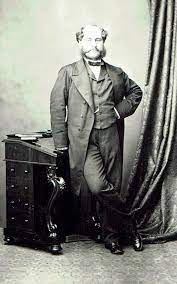(A contemporary of architect Chisholm, engineer Major Morant’s legacy in the Nilgiris is unparalleled. He was undoubtedly the Father of Nilgiri Mountain Railway. The roads, utilities and buildings he constructed still serve as proud lifelines for the district)
Major and Brevet Liuet-Colonel James Law Lushington Morant of the Royal Engineers was born in Belgaum, India to a Madras Army Chaplain. He joined Madras Sappers and Miners in January, 1862. Before that he served in PWD in Bombay, where his contributions still stand and a café is said to be named after him in the whereabouts of the Victoria Terminus.
When he was posted as District Engineer of Nilgiris, though his jurisdiction did not cover the railways, he launched a relentless campaign for a mountain railway starting with an elaborate report of his own in 1855 which answered all the doubts of the worst skeptics of the proposal. He followed it up with his paper ‘Mountain Railways for the Nilgiri Hills’ in 1874 running to 44 pages with several pictures. It was at Major Morant’s instigation the famous Riggenbach of the Rigi system of mountain railway paid a visit to the Nilgiris. Alas ! he did not live to see his work becoming a reality in 1899.
The present scenic ghat road, wide and with a gentle gradient, from Kotagiri to Mettupalyam was traced and constructed by Major Morant in 1872-75.
Lamenting that, ‘ The site of Ootacamund has been well chosen but from its commencement it has never been systematically treated, the town having been allowed to grow up uncontrolled’, Major Morant, singlehandedly, drew up the present system of drinking water and drainage plan for the town in 1870. In 1877 Morant, drew up a scheme for improving the Marlimand supply by adding three more reservoirs.
As a true son a Chaplin, Major Morant, ‘who had a special penchant for ecclesiastical architecture’, built the Chancel of All Saints Church and the Roman Catholic church (St. Joseph’s) at Coonoor, the Anglican church (St. George’s) at Wellington and the Protestant Church at Gudalur.
Chisholm and Morant worked together on many buildings including the Lawrence school buildings and the old Breeks School (now the Court complex). It was Morant’s idea to put up a clock tower to the court buildings in 1878 when the question arose as to what to do with the public subscription that was collected for a reception to then Prince of Wales who cancelled the visit owing to prevalence of cholera epidemic.
Morant worked with Chisholm on many Madras landmarks also like the Post and Telegraph Office.
In his capacity as an architect Colonel Morant entered into the competition for the Municipal Hall and offices at Bombay in 1884 and obtained the second prize of Rs. 3,000, the successful competitor being Mr. Chisholm. Morant built the hall and the offices.
Colonel Morant took much interest in all branches of his profession and wrote extensively. He also collaborated with the French Astronomer Janssen during his visit to the Nilgiris to observe the solar eclipse.
Major Morant died in Australia on 17th June 1886 due to a terminal disease. A memorial plaque in St. Mary’s Church, Chennai commemorates him.
Image: Like many benefactors of Nilgiris, Major Morant too did not leave behind any of his own pictures. When we did the Nilgiri history calendar 2019 we showed his back talking to the founder Roman Abt as a mark of remembrance.
Nilgiri Documentation Centre

